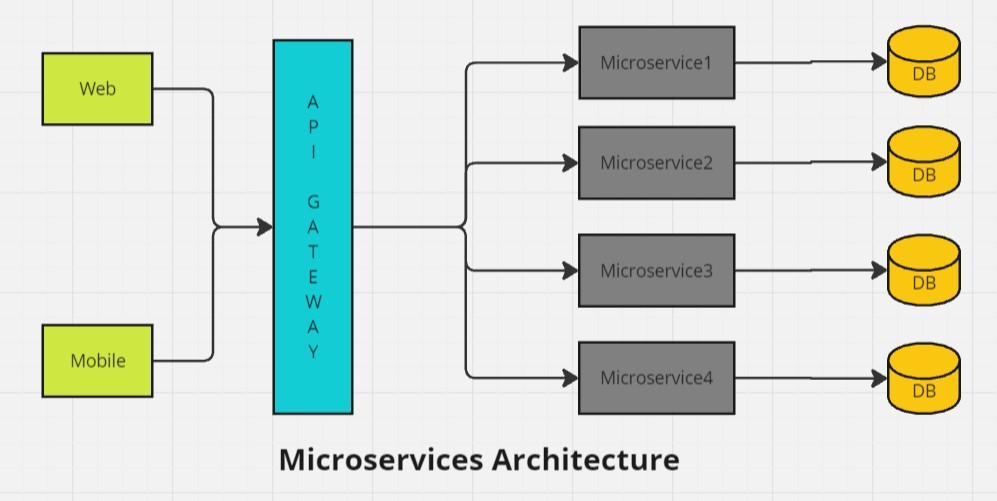What are Microservices
Microservices - also known as the microservice architecture - is an architectural style that structures an application as a collection of services that are:
- Independently deployable
- Loosely coupled
Microservices are an architectural approach to develop software applications as a collection of small, independent services that communicate with each other over a network. Instead of building a monolithic application where all the functionality is tightly integrated into a single codebase, microservices break down the application into smaller, loosely coupled services.
Microservice is a small, loosely coupled distributed service. Each microservice is designed to perform a specific business function and can be developed, deployed, and scaled independently. It allows you to take a large application and decompose or break it into easily manageable small components with narrowly defined responsibilities. It is considered the building block of modern applications. Microservices can be written in a variety of programming languages, and frameworks, and each service acts as a mini-application on its own.

How do Microservices work
Microservices work by breaking down a complex application into smaller, independent pieces that communicate and work together, providing flexibility, scalability, and easier maintenance, much like constructing a city from modular, interconnected components.
-
Modular Structure:
- - Microservices architecture breaks down large, monolithic applications into smaller, independent services.
- - Each service is a self-contained module with a specific business capability or function.
- - This modular structure promotes flexibility, ease of development, and simplified maintenance.
-
Independent Functions:
- - Each microservice is designed to handle a specific business function or feature.
- - For example, one service may manage user authentication, while another handles product catalog functions.
- - This independence allows for specialized development and maintenance of each service.
-
Communication:
- - Microservices communicate with each other through well-defined Application Programming Interfaces (APIs).
- - APIs serve as the interfaces through which services exchange information and requests.
- - This standardized communication enables interoperability and flexibility in integrating services.
-
Flexibility:
- - Microservices architecture supports the use of diverse technologies for each service.
- - This means that different programming languages, frameworks, and databases can be chosen based on the specific requirements of each microservice.
- - Teams have the flexibility to use the best tools for their respective functions.
-
Independence and Updates:
- - Microservices operate independently, allowing for updates or modifications to one service without affecting the entire system.
- - This decoupling of services reduces the risk of system-wide disruptions during updates, making it easier to implement changes and improvements.
- - Also Microservices contribute to system resilience by ensuring that if one service encounters issues or failures, it does not bring down the entire system.
-
Scalability:
- - Microservices offer scalability by allowing the addition of instances of specific services.
- - If a particular function requires more resources, additional instances of that microservice can be deployed to handle increased demand.
- - This scalability is crucial for adapting to varying workloads.
-
Continuous Improvement:
- - The modular nature of microservices facilitates continuous improvement.
- - Development teams can independently work on and release updates for their respective services.
- - This agility enables the system to evolve rapidly and respond to changing requirements or user needs.
Components of microservices
- Microservices: These are the individual, self-contained services that encapsulate specific business capabilities. Each microservice focuses on a distinct function or feature.
- API Gateway: The API Gateway is a central entry point for external clients to interact with the microservices. It manages requests, handles authentication, and routes requests to the appropriate microservices.
- Service Registry and Discovery: This component keeps track of the locations and network addresses of all microservices in the system. Service discovery ensures that services can locate and communicate with each other dynamically.
- Load Balancer: Load balancers distribute incoming network traffic across multiple instances of microservices. This ensures that the workload is evenly distributed, optimizing resource utilization and preventing any single service from becoming a bottleneck.
- Containerization: Containers, such as Docker, encapsulate microservices and their dependencies. Orchestration tools, like Kubernetes, manage the deployment, scaling, and operation of containers, ensuring efficient resource utilization.
- Event Bus/Message Broker: An event bus or message broker facilitates communication and coordination between microservices. It allows services to publish and subscribe to events, enabling asynchronous communication and decoupling.
- Centralized Logging and Monitoring: Centralized logging and monitoring tools help track the performance and health of microservices. They provide insights into system behavior, detect issues, and aid in troubleshooting.
- Database per Microservice: Each microservice typically has its own database, ensuring data autonomy. This allows services to independently manage and scale their data storage according to their specific requirements.
- Caching: Caching mechanisms can be implemented to improve performance by storing frequently accessed data closer to the microservices. This reduces the need to repeatedly fetch the same data from databases.
- Fault Tolerance and Resilience Components: Implementing components for fault tolerance, such as circuit breakers and retry mechanisms, ensures that the system can gracefully handle failures in microservices and recover without impacting overall functionality.
Microservice Design Patterns
- 1. Aggregator
- 2. Strangler
- 3. Circuit Breaker
- 4. API Gateway
- 5. Database per Service
- 6. Command Query Responsibility Segregation (CQRS)
- 7. Saga Pattern